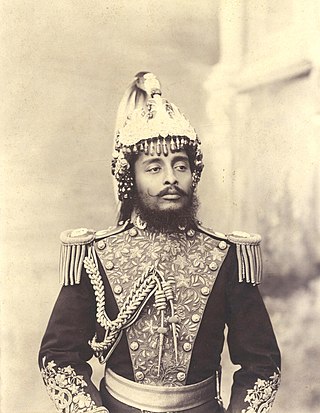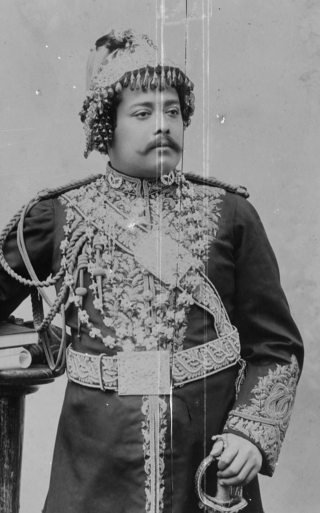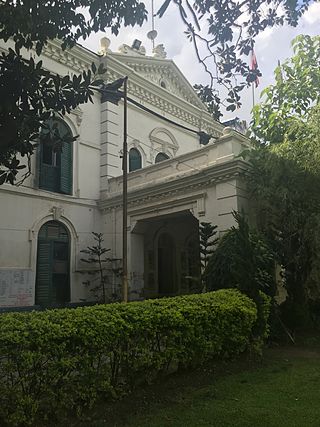
The Rana dynasty were a Chhetri dynasty that imposed authoritarianism in the Kingdom of Nepal from 1846 until 1951, reducing the Shah monarch to a figurehead and making the Prime Minister and other government positions held by the Ranas hereditary. They are Kshatriya, whose ancestors were descended from the Ranas of Udaipur, Rajasthan, India. The Rana dynasty is historically known for their iron-fisted rule. This changed after the Revolution of 1951 with the promulgation of a new constitution, when power shifted back to the monarchy of King Tribhuvan.

The Rastrapati Bhawan is the official residence of the President of Nepal, located in Kathmandu, Nepal. It hosts the Office of The President of Nepal. The main palace building is also known as Shital Niwas. It was built by Prime Minister Chandra Shumsher Jung Bahadur Rana in 1923.

Field-Marshal His Highness Maharaja Sri Teen Chandra Shumsher Jung Bahadur Rana was the Prime Minister of Nepal from the Rana dynasty. He served in this capacity from 27 June 1901 to his death in 1929 after he successfully deposed his liberal and reformist brother Dev Shamsher. Although generally perceived as despotic and conservative, he is credited with several reforms including the abolition of slavery and establishing the Nepal-Britain Treaty of 1923, which recognised Nepal as an independent nation and an ally of Britain.

The Narayanhiti Palace Museum is a public museum in Kathmandu, Nepal located east of the Kaiser Mahal and next to Thamel. The museum was created in 2008 from the complex of the former Narayanhiti Palace following the 2006 revolution. Before the revolution, the palace was the residence and principal workplace of the monarch of the Kingdom of Nepal, and hosted occasions of state.

Sri Maharaja, Dev Shumsher Jung Bahadur Rana was the Prime Minister of Nepal for 114 days in 1901. He was also the King of Lamjung and Kaski.
Baber Mahal Revisited is a heritage complex in Kathmandu containing restaurants and shops. The complex comprises restaurants, art galleries and book shops.

Thapathali Durbar was a palace complex in Kathmandu, the capital of Nepal. Thapathali means abode of the Thapas. It was initially built by Nain Singh Thapa of the Thapa dynasty but was later occupied by Jung Bahadur Rana, as prime minister, the executive head of Nepal. The palace complex, located north of the Bagmati river, encompasses an impressive and vast array of courtyards, gardens, and buildings. Many palaces and buildings were built throughout late 1840s to 1900, initially by Nain Singh Thapa, a member of the aristocratic Thapa family and brother of Bhimsen Thapa, and later was acquired by Nain Singh Thapa's grandson Jung Bahadur Rana. Further additions were made by successive Ranas up to the 19th century.

Babar Mahal, Baber Mahal is a Rana palace in Kathmandu, the capital of Nepal. The palace complex, located north of the Bagmati river, was incorporated in an impressive and vast array of courtyards, gardens and buildings. Initially, the palace was under Jung Bahadur Rana's Thapathali Durbar but was later separated, demolished and rebuilt by Chandra Shumsher Jang Bahadur Rana, as prime minister and the executive leader of Nepal.

Kaiser Mahal is a Rana palace in Kathmandu, the capital of Nepal. The palace complex, located west of the Narayanhity Palace, was incorporated in an impressive and vast array of courtyards, gardens and buildings.

Bag Durbar, is a palace in Kathmandu, Nepal, west of the Dharahara and Tundikhel. Initially the palace was owned by Amar Singh Thapa (Sardar) of the Thapa regime and his descendant, but later was occupied by the Royals of the Shah dynasty, and later by the government of Nepal.

Bahadur Bhawan is a Rana palace in Kathmandu, the capital of Nepal. The palace complex, located west of Jamal, north of Keshar Mahal was incorporated in an impressive and vast array of courtyards, gardens and buildings. The palace was built by Bir Shumsher JBR and rebuilt by Rudra Shumsher JBR after its destruction by fire in BS 1962.

Seto Durbar was a Rana palace in Kathmandu, the capital of Nepal. The palace complex, located south of the Narayanhity Palace, was incorporated in an impressive and vast array of courtyards, furnishings and guest halls. Seto Durbar was built by Bir Shumsher Jung Bahadur Rana in 1893 CE.
Jaulakhel Durbar was a Rana palace in Jawalakhel, Lalitpur, the capital city of Nepal. Jaulakhel Durbar was built by Bir Shumsher Jang Bahadur Rana in 1954 BS.

Lazimpat Durbar, Aka Agni Bhawan is a palace complex in Kathmandu, the capital of the Nepal. Initially build and occupied by Kaji Bir Keshar Pande but later palace area was occupied by Bir Shumsher JBR, as prime minister the executive head of Nepal. The palace complex, located next to the historic Narayanhity Palace Museum, was incorporated impressive and vast array of courtyards, gardens and buildings.
Lakshmi Niwas is a Rana palace in Maharajgunj, Kathmandu, the capital of Nepal. The palace complex, located north of the Bagmati river, was incorporated in an impressive and vast array of courtyards, gardens and buildings. It was built by Chandra Shumsher JBR, at the time prime minister and the executive leader of Nepal.

Harihar Bhawan is a Rana palace in Patan, the capital of Nepal. The palace complex, located west of the Shree Durbar, was incorporated into a vast array of courtyards, gardens and buildings.

Shree Durbar is a Rana palace in Kathmandu, Patan, Nepal the capital of Nepal. The palace complex, located east of the Lazimpat Durbar next to Patan Dhoka, was incorporated in an impressive and vast array of courtyards, gardens and buildings. Sri Durbar was built by Chandra Shumsher JBR in 1927.
Charburja Durbar was a palace within Thapathali Durbar Complex in Kathmandu, the capital of the Nepal. Charburja literally translates Four Burg Palace. This palace was built by Jung Bahadur Rana in the year 1849 for Jind Kaur youngest Queen consort of Maharaja Ranjit Singh of Sikh Empire.
Ranasur Bista, was a Nepali architect who is considered to be one of the key figures in the building of early Rana palaces of Nepal. Bista is among the pioneer master masons of Nepal in introducing European building style with Traditional Vastu shastra. He is best known for designing and engineering palaces for the first Rana prime minister of Nepal Jung Bahadur Rana.

Lieutenant-General Sir Krishna Shumsher Jung Bahadur Rana was a Nepalese diplomat who served as the Nepalese Ambassador to the United Kingdom from 1935 to 1939.




















